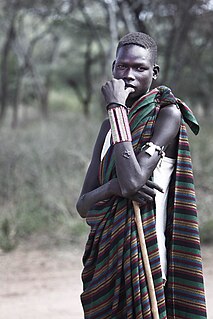The Didinga (diDinga) occupy the Didinga Mountains region in Budi County, Eastern Equatoria State in South Sudan. They live in the valleys, on the plateaus and slopes, and on the adjacent plains of the region. Their neighbors include the Toposa, the Boya, Ketebo, Logir, Teuth and Dongotona peoples - groups with whom the Didinga have had frequent conflicts due to economic pressures.

The Toposa are an ethnic group in South Sudan, living in the Greater Kapoeta region of the erstwhile Eastern Equatoria state. They have traditionally lived by herding cattle, sheep and goats, and in the past were involved in the ivory trade. They have a tradition of constant low-level warfare, usually cattle raids, against their neighbors.

Kapoeta is a town in South Sudan. It is located in Kapoeta South County, in Namorunyang State, in southeastern South Sudan.
The Boya are an ethnic group numbering 20,000 to 25,000 people living in Budi County, part of the Greater Kapoeta region of the South Sudanese state of the erstwhile Eastern Equatoria.
The Koss River is a river that flows in a north of northwest direction through the erstwhile Eastern Equatoria state of South Sudan, fed by streams from the Imatong Mountains to the west.

Budi County is an administrative area of Namorunyang State. Before the reorganisation of states in 2015, it was a part of Eastern Equatoria state in South Sudan, with headquarters in Chukudum.
Peter Lorot is a former officer who served with the Sudan People's Liberation Army (SPLA) during the Second Sudanese Civil War (1983-2005). He broke away from the SPLA in 1999 with a Didinga force based on Chukudum, in Budi County of Eastern Equatoria State in South Sudan. In the resulting conflict many people were displaced. As of April 2011 Lorot's forces were still not reconciled with the de facto SPLM government.

Greater Kapoeta is the name given to the eastern half of the erstwhile Eastern Equatoria State in South Sudan, at one time an administrative region with headquarters in the town of Kapoeta. Greater Kapoeta was divided between Kapoeta County and Budi County, named after the Buya and Didinga (BU-DI) people. Kapoeta County was later split into Kapoeta North, South and East counties.

Namorunyang is a village and Payam of Kapoeta South County in Namorunyang State, South Sudan.

Narus is a community in the Namorunyang State state of South Sudan. It is the headquarters of Kapoeta East County.

Nadapal is a community in the south west of Kapoeta East County, South Sudan near the border with the Rift Valley province of Kenya. The Nadapal belt is an area stretching 25 kilometres (16 mi) southward from the border with South Sudan to Lokichogio in Kenya.
The Singaita River is a river in Eastern Equatoria state of South Sudan that flows through the town of Kapoeta.
The Loyuro River is a stream in Eastern Equatoria State of South Sudan. The river originates in the east of Didinga Hills, flowing eastward into Greater Kapoeta and discharging into the swampy area northeast of Narus. The river floods during the rainy season, but ceases to flow at other times. The Toposa people have a ritual center at Loyuro River. Lolimi is a permanent water hole on the river, on the road between Narus and Kapoeta.

Riwoto is a community in Eastern Equatoria state of South Sudan. It is a payam and village in Kapoeta North County.
Natinga is a refugee camp and a school that was established in 1993 in South Sudan for boys forced from their homes by the Second Sudanese Civil War. It is the center of a payam in Kapoeta East County of Eastern Equatoria.

Kapoeta East County is an administrative region of Namorunyang State. Before reorganisation of states in 2015, it was a part of Eastern Equatoria state in South Sudan, bordered by Kenya to the south, Ethiopia to the east and Jonglei state to the west. It is part of the Greater Kapoeta region of the state. The largest ethnic group is the Toposa people. The principal town is Narus. The county includes the disputed Ilemi triangle, controlled by Kenya. The emblem of the county is a horned bull, with big humps and a large tail.

Nanyangachor is a community in Eastern Equatoria state of South Sudan. It is in the Eastern Uplands of Kapoeta East County, near the border with Ethiopia.

Kapoeta North County is an administrative division of Namorunyang State. Before reorganisation of states in 2015, it was part of Eastern Equatoria state in South Sudan. The principal settlement is Riwoto and the largest ethnic group are the Toposa people. The county emblem is an elephant.








